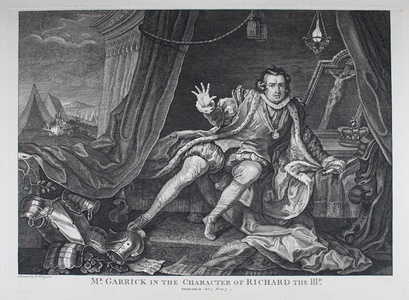| Method | Copper engraving |
| Artist | after William Hogarth |
| Published | Painted by Wm. Hogarth. [Robert Sayer. London, 1767] |
| Dimensions | Image 235 x 335 mm, Plate 255 x 355 mm, Sheet 285 x 448 mm |
| Notes |
A reduced engraving after Hogarth's Mr. Garrick in the Character of Richard the 3d, from Robert Sayer's Les Satyres de Guillaume Hogarth Oeuvre Moral et Comique. Sayer published Les Satyres under the auspices of Jane Hogarth, who had been granted copyright over her late husband's works by Act of Parliament. A superb engraving of the actor David Garrick in his celebrated lead role in Shakespeare's Richard III, performed at Goodman's Fields on the 19th of October, 1741. Garrick was a close friend of Hogarth's, and one of his greatest supporters. Aside from purchasing Hogarth's Election paintings and acting as an advocate for the artist in London society, it was Garrick that ultimately penned the inscription for Hogarth's tombstone, which lauded him as the 'Great Painter of Mankind.' The scene depicted in the engraving is Act 5, Scene 3, as Richard awakes from a haunting dream in his tent just before the Battle of Bosworth Field. The king's armour rests against an ivy-covered pillar in the bottom left corner, his helmet's crest featuring the boar of York resting on a scrap of Norfolk's letter. The opulence of the king's clothing, daybed, drapery, and tent speak to his majesty and importance. At the head of his daybed, the crown rests on a small sidetable before a framed image of the crucifixion. Aside from celebrating the first major success of a close personal friend and the career beginnings of the greatest actor of the age, Hogarth's rendering of the scene also speaks volumes to his skill as a grand history painter, with the King's figure following the 'serpentine' line of beauty that Hogarth so favoured. The inscription below reads: 'Mr. Garrick in the Character of Richard the IIId: Shakespear Act 5. Scene 7.' William Hogarth (1697 - 1764) was born in London, the son of an unsuccessful schoolmaster and writer from Westmoreland. After apprenticeship to a goldsmith, he began to produce his own engraved designs in about 1710. He later took up oil painting, starting with small portrait groups called conversation pieces. He went on to create a series of paintings satirising contemporary customs, but based on earlier Italian prints, of which the first was The Harlot's Progress (1731), and perhaps the most famous The Rake's Progress. His engravings were so plagiarised that he lobbied for the Copyright Act of 1735, commonly referred to as 'Hogarth's Act,' as a protection for writers and artists. During the 1730s Hogarth also developed into an original painter of life-sized portraits, and created the first of several history paintings in the grand manner. Robert Sayer (1725-1794) was one of the most prolific and successful British publishers, cartographers, and print-sellers of the Georgian era. Following his brother's marriage to the daughter in law of the publisher John Overton, Sayer continued the business, branching out into sea charts, maritime atlases, and general maps. In addition to his cartographic achievements, Sayer was also instrumental in growing the public taste for prints after paintings, particularly those by Johan Zoffany, with whom he developed a lifelong friendship as well as a lucrative business partnership. Following his death, the business was continued by Laurie and Whittle. Condition: Excellent impression. Minor time toning and surface dirt to edges of sheet, not affecting plate. |
| Framing | unmounted |
| Price | £100.00 |
| Stock ID | 50694 |

